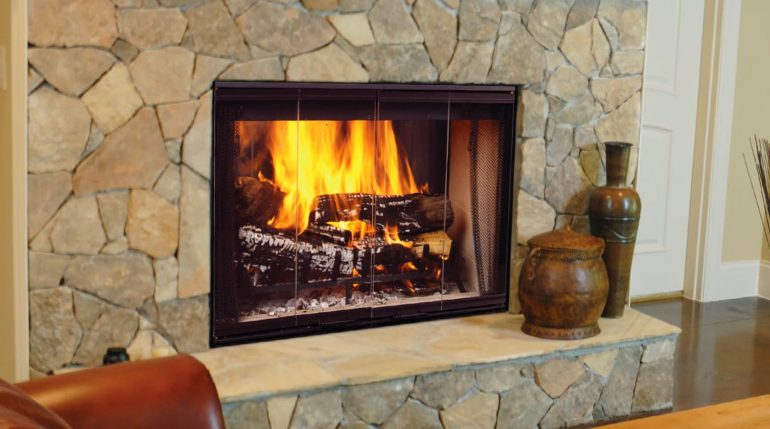For the past three years, scientists have been observing in major urban centers that the shift to cheaper heating with firewood burning in fireplaces and stoves is causing a sharp rise in air pollution prices.
Some talk about the serious contribution of wood burning to the return of "an old acquaintance", the smog cloud, when the weather conditions favor its creation. It is noted that a traditional fireplace emits 30 times more suspended particles into the atmosphere than a well-maintained burner of an apartment building with 25 apartments.
Air pollution can lead to respiratory problems, worsen allergies, and cause neurological, reproductive, and developmental problems. This is especially true for vulnerable populations, such as children, the elderly, pregnant women, and those suffering from respiratory and cardiovascular problems.
Local heat only
As for the heating efficiency of the urban fireplace, it is already small, only 15% of the heat is produced by burning wood, while the heat it provides is only local and contributes little to the overall heating of a house. According to instructions issued by the Center for the Control of Special Infections in Greece, it is necessary to know that:
· It is strictly forbidden to burn painted (especially oil paints) or varnished wood, pieces of furniture and any kind of plastic, as they lead to the emission of toxic gases inside and outside the house.
· The use of chemical lighters is also prohibited. It is better to use natural lighters such as torches. Also avoid buying wood impregnated with chemicals, intended for slow burning, easy ignition, etc.
General precautionary instructions
In the ignition (ignition) phase of the fire, flammable liquids should not be used, because they form vapors, which cause small explosions. These can transmit fire uncontrollably to adjacent flammable materials such as fabrics, curtains, etc. It is safer to use commercial lighters, traditional torch or paper.
If you use a wood stove, it should not be placed on a carpet or near furniture or curtains, as its heat can ignite them. It is preferable for the stove to be on the floor and if it is wooden, on a non-flammable surface, such as e.g. marble, so that even if a coal or a ditch escapes there is no risk of fire.
It is also important to choose the installation of ventilation pipes (rain), so that they do not come into contact with wood or other flammable surfaces, while their regular cleaning, as well as the chimney, from tar and soot (ash) is just as important. Residues of tar and ash in the rain can ignite at very high temperatures and lead to glowing of the pipes (rain). The concentration of tar and soot is a function of the purity of the wood we choose to burn, something that also applies to newer types of fuel such as pellets.
Burns and injuries
It is also important to educate children about the dangers of using a wood-burning stove indoors to avoid burns or other injuries. To extinguish the air supply must be closed and the door must be secured, while the removal of ash and coals must be done carefully with the use of a non-flammable component.
Carbon monoxide
Carbon monoxide (CO) is an odorless and colorless gas. Exposure to high concentrations of carbon monoxide can lead to poisoning and even death.
CO is contained in combustion gases, such as those produced by cars or trucks, by stoves, stoves, lanterns, braziers, fireplaces and burners. If carbon monoxide accumulates indoors or in small spaces, it can lead to poisoning of animals and humans.
Symptoms of poisoning
The most common symptoms of carbon monoxide poisoning are headache, dizziness, weakness, nausea and vomiting, chest pain and confusion. Exposure to high concentrations can lead to loss of consciousness and death. Particularly dangerous is exposure to carbon monoxide during sleep or in people who are drunk, who may die without symptoms. Carbon monoxide poisoning has no specific symptoms and must be clinically suspected for diagnosis.
What is the mechanism of carbon monoxide poisoning?
The hemoglobin in red blood cells binds more quickly and efficiently to CO than to oxygen. If there is an increased concentration of CO in the atmosphere, then a large percentage of red blood cells will carry CO instead of the oxygen that all human tissues need to function. This can lead to tissue damage and death.
Who is at risk?
ALL humans and animals can be poisoned by CO. Some groups of the population such as fetuses, infants and people with chronic heart or respiratory problems are more sensitive to the effects of carbon monoxide. It is estimated that carbon monoxide poisoning leads a large number of patients to visit the Emergency Department (ICU) (> 20.000 in the US).
To prevent CO poisoning in the home you should regularly service heating systems that run on oil, gas, coal or other biomass by a qualified technician, avoid the use of gas or coal heaters indoors (through , caravan, etc.), always prefer devices that have the CE mark. Finally, if you use a stove, fireplace or biomass burner, it is advisable to install a battery-operated CO detector.

